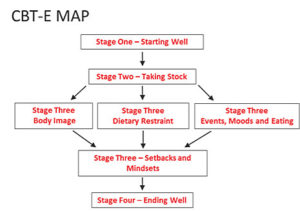CBT-E is the abbreviation for “enhanced cognitive behaviour therapy”, and is one of the most effective treatments for eating disorders. It is a “transdiagnostic” treatment for all forms of eating disorder including anorexia nervosa, bulimia nervosa, binge eating disorder and other similar states.
It was developed as an outpatient treatment for adults but is available as an intensive version for day patients and inpatients. There is also a version for younger people. Detailed treatment guides are available for CBT-E.
When working with people who are not significantly underweight, CBT-E generally involves an initial assessment appointment followed by 20 treatment sessions over 20 weeks, lasting 50-minutes each.
CBT-E isn’t a “one-size-fits-all” treatment. CBT-E is a highly individualised treatment. The therapist creates a specific version of CBT-E to match the exact eating problem of the person receiving treatment. CBT-E has four stages (see CBT-E map below).

Stage One, the focus is on gaining a mutual understanding of the person’s eating problem and helping him or her to modify and stabilise their pattern of eating. There is also emphasis on personalised education and the addressing of concerns about weight. It is best if these initial sessions are twice a week.
In the brief second stage, progress is systematically reviewed and plans are made for the main body of treatment (Stage Three).
Stage Three consists of a run of weekly sessions focused on the processes that are maintaining the person’s eating problem. Usually this involves addressing concerns about shape and eating; enhancing the ability to deal with day-to-day events and moods; and the addressing of extreme dietary restraint.
Towards the end of Stage Three and in Stage Four the emphasis shifts onto the future. There is a focus on dealing with setbacks and maintaining the changes that have been obtained.
Generally a review session is held some months after treatment has ended. It provides an opportunity for a review of progress and the addressing of any problems that remain or have emerged.
With people who are underweight, treatment needs to be longer, often involving around 40 sessions over 40 weeks. In this version of CBT-E, weight regain is integrated with addressing eating disorder psychopathology. Before embarking on weight regain, patients and therapists spend the first weeks of this treatment carefully considering the reasons for and against this change. The goal in CBT-E is that patients themselves decide to regain weight rather than having this decision imposed upon them. During the final step of weight regain the patient becomes accomplished at maintaining their weight.

